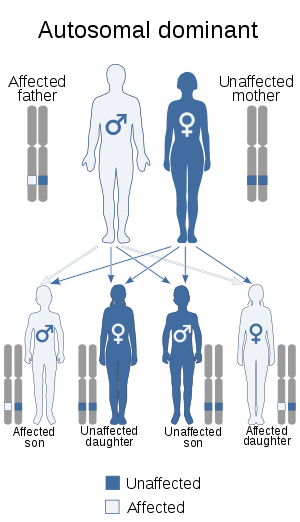MASS syndrome
| MASS syndrome | |
|---|---|
 | |
| This condition is inherited in an autosomal dominant manner | |
| Classification and external resources | |
| Specialty | medical genetics |
| OMIM | 04308 |
| MeSH | C536030 |
| Orphanet | 99715 |
MASS syndrome is a medical disorder of the connective tissue similar to Marfan syndrome. MASS stands for: Mitral valve prolapse, Aortic root diameter at upper limits of normal for body size, Stretch marks of the skin, and Skeletal conditions similar to Marfan syndrome. It is caused by a mutation in the FBN1 gene, which encodes fibrillin-1.[1] Fibrillin-1 is an extracellular matrix protein that is found in microfibrils;[2] defects in the fibrillin-1 protein cause the malfunctioning of microfibrils,[3] which results in improper stretching[3] of ligaments, blood vessels, and skin.
Treatment options for MASS syndrome are largely determined on a case-by-case basis and generally address the symptoms as opposed to the actual disorder;[4] furthermore, due to the similarities between these two disorders, individuals with MASS syndrome follow the same treatment plans as those with Marfan syndrome.[5]
Other possible symptoms are mitral valve prolapse, a large aortic root diameter, and myopia.[1] The skeletal features found in MASS syndrome include curvature of the spine (scoliosis), chest wall deformities, and joint hypermobility.[1]
MASS syndrome and Marfan syndrome are overlapping connective tissue disorders. Both can be caused by mutations in the gene encoding a protein called fibrillin. These conditions share many of the same signs and symptoms including long limbs and fingers, chest wall abnormalities (indented chest bone or protruding chest bone), flat feet, scoliosis, mitral valve prolapse, loose or hypextensible joints, highly arched roof of the mouth, and mild dilatation of the aortic root. Unlike in Marfan syndrome, aneurysm is not present.[1]
Individuals with MASS syndrome do not have progressive aortic enlargement or lens dislocation, while people with Marfan syndrome do. Skin involvement in MASS syndrome is typically limited to stretch marks (striae distensae). Also, the skeletal symptoms of MASS syndrome are generally mild.
References
- 1 2 3 4 "MASS PHENOTYPE". Marfan Foundation. Retrieved 19 February 2018.
- ↑ Jacobs, Amanda M.; Toudjarska, Ivanka; Racine, Andrew. "A recurring FBN1 gene mutation in neonatal Marfan syndrome". Archives of Pediatrics & Adolescent Medicine. 156(11): 1081-1085. doi:10.1001/archpedi.156.11.1081.
- 1 2 "FBN1 gene". Genetics Home Reference. NIH. Retrieved 8 November 2017.
- ↑ Anon. MASS syndrome. Genetic and Rare Diseases Information Center [Internet]. Available from: https://rarediseases.info.nih.gov/diseases/8489/mass-syndrome
- ↑ Pyeritz, Reed E.; for the Professional Practice and Guidelines Committee, Acmg (January 2012). "Evaluation of the adolescent or adult with some features of Marfan syndrome". Genetics in Medicine. 14 (1): 171–177. doi:10.1038/gim.2011.48. ISSN 1098-3600.